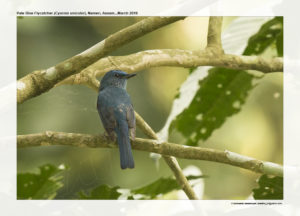Pale-blue Flycatcher

Pale Blue Flycatcher Cyornis unicolor
Etymology:
- Cyornis : Greek Word kuanos dark-blue; ornis –bird
- Unicolor : Latin word uni– single-; color-colour { Plain}
Distribution in India: Resident in North East India and Summer Visitor to Himalayas.
Description:Size of 17-18 cm. It is a Medium-sized to large, slim and long-tailed, blue (male) or brown-grey (female) flycatcher. Male nominate race is almost entirely cobalt-blue, including brighter blue edges of otherwise sooty tail and edges of darker flight-feathers, and bright blue eyering, except for paler forehead to over eye, blackish lores, slightly paler blue chin to breast and greyer belly to undertail-coverts; iris dark brown; bill black; legs brown to dark grey. Female has head and most of upperparts brownish-grey or pale tawny, narrow whitish eyering (sometimes a narrow turquoise band on lower forehead), uppertail-coverts rufous-brown, tail rufous-chestnut, underparts mostly pale greyish, paler or whitish on center of belly and buff undertail-coverts. . Flicks tail and droops wings when agitated.
Habitat:It is found in Moist forests, mostly dense primary and secondary broadleaf hill forest and lower montane forest, also bamboo. Found between 275 m and 1525 m.
Food Habits: It eats small invertebrates. It is found solitary or in pairs; occasionally joins mixed-species flocks. It is fairly shy or inconspicuous. Forages in typical flycatcher fashion, pursuing passing insects in aerial flight, usually returning to different perch; forages also among branches of middle and upper canopy of forest trees, and occasionally lower or near ground.
Breeding Habits: They breed in Apr-Jun in India. The nest an open cup of moss, rootlets, bryophytes, plant fibers and lichens, placed in hole in tree stump or between stones in earth bank, or attached by gossamer to rock or overhanging boulder in stream gulley. It lays a clutch 2–3 eggs.